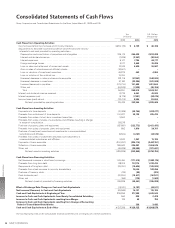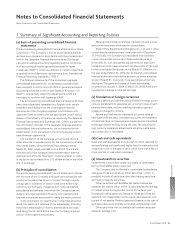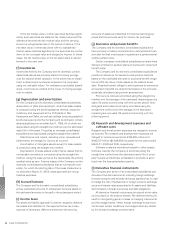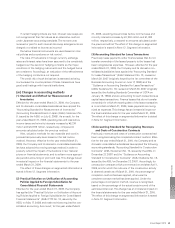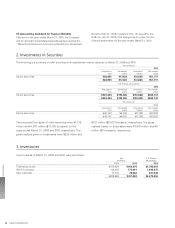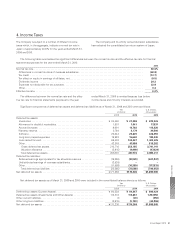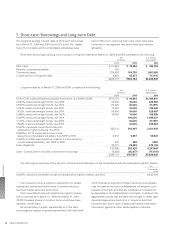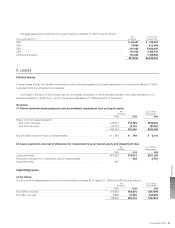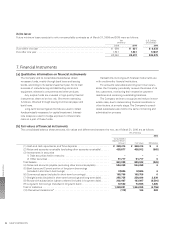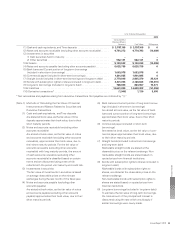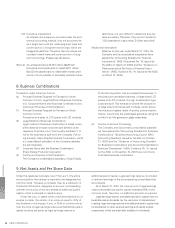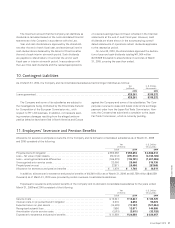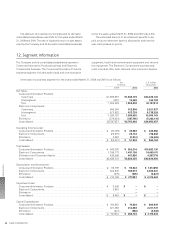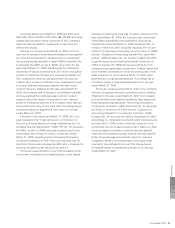Sharp 2010 Annual Report Download - page 58
Download and view the complete annual report
Please find page 58 of the 2010 Sharp annual report below. You can navigate through the pages in the report by either clicking on the pages listed below, or by using the keyword search tool below to find specific information within the annual report.
(10) Derivative transactions
As interest-rate swaps are recorded under the pref-
erential accounting method, they are accounted for
as a single item with the underlying bank loans and
current portion of long-term borrowings; which are
hedged transactions. Therefore their fair values are
included in bank loans and current portion of long-
term borrowings. (Please see (5) above.)
(Note 2) As unlisted stocks ¥ 39,487 million ($429,207
thousand) and investments in capital ¥371 million
($4,033 thousand) have no observable market price
and as it is not possible to accurately estimate future
cash flows, it is very difficult to determine their fair
value accurately. Therefore, they are not included in
“(3) Investments in securities; 2) Other securities.”
(Additional Information)
Effective for the year ended March 31, 2010, the
Company and its consolidated subsidiaries have
applied the “Accounting Standard for Financial
Instruments” (ASBJ Statement No. 10, issued by
the ASBJ on March 10, 2008) and the “Guidance on
Disclosures about Fair Value of Financial Instru-
ments” (ASBJ Guidance No. 19, issued by the ASBJ
on March 10, 2008).
8. Business Combinations
Transaction under Common Control
(a) Principal Business Targeted for Transaction Under
Common Control, Legal Method of Business Combina-
tion, Corporate Name after Business Combination and,
Outline and Purpose of the Transaction
(1) Principal Business Targeted for Transaction Under
Common Control
Production and sales of LCD panels and LCD modules
(2) Legal Method of Business Combination
Legal method of business combination is called, a sim-
plified absorption-type corporate split defined under
Japanese Corporate Law (“kani-kyushu-bunkatsu”), in
which the business is split from the Company. Follow-
ing this split, Sharp Display Products Corporation, which
is a consolidated subsidiary of the Company, absorbs
the split business.
(3) Corporate Name after the Business Combination
Sharp Display Products Corporation
(4) Outline and Purpose of the Transaction
The Company’s consolidated subsidiary, Sharp Display
Products Corporation, has succeeded the business, in
the production and sales business, of large-sized LCD
panels and LCD modules, through an absorption-type
corporate split. This transaction allows the production
of large-sized LCD panels and modules, which deliver
the industry’s highest levels of quality, cost and perfor-
mance, maximizing the advantages gained by using the
world’s first 10th generation glass substrates.
(b) Outline of Account Processing
The Company and its domestic consolidated subsidiar-
ies have applied the “Accounting Standard for Business
Combinations” (Business Accounting Council (BAC)
Accounting Standard, issued by the BAC on October
31, 2003) and the “Guidance on Accounting Standard
for Business Combinations and Accounting Standard for
Business Divestitures” (ASBJ Guidance No. 10, issued
by the ASBJ on November 15, 2007) as a commonly-
controlled business combination.
9. Net Assets and Per Share Data
Under the Japanese Corporate Law (“the Law”), the entire
amount paid for new shares is required to be designated as
common stock. However, a company may, by a resolution of
the Board of Directors, designate an amount not exceeding
one-half of the price of the new shares as additional paid-in
capital, which is included in capital surplus.
Under the Law, in cases where a dividend distribution of
surplus is made, the smaller of an amount equal to 10% of
the dividend or the excess, if any, of 25% of common stock
over the total of legal earnings reserve and additional paid-in
capital must be set aside as legal earnings reserve or
additional paid-in capital. Legal earnings reserve is included
in retained earnings in the accompanying consolidated bal-
ance sheets.
As of March 31, 2010, the total amount of legal earnings
reserve and additional paid-in capital exceeded 25% of the
common stock, therefore, no additional provision is required.
Legal earnings reserve and additional paid-in capital may not
be distributed as dividends. By the resolution of shareholders’
meeting, legal earnings reserve and additional paid-in capital may
be transferred to other retained earnings and capital surplus,
respectively, which are potentially available for dividends.
Financial Section
SHARP CORPORATION56


